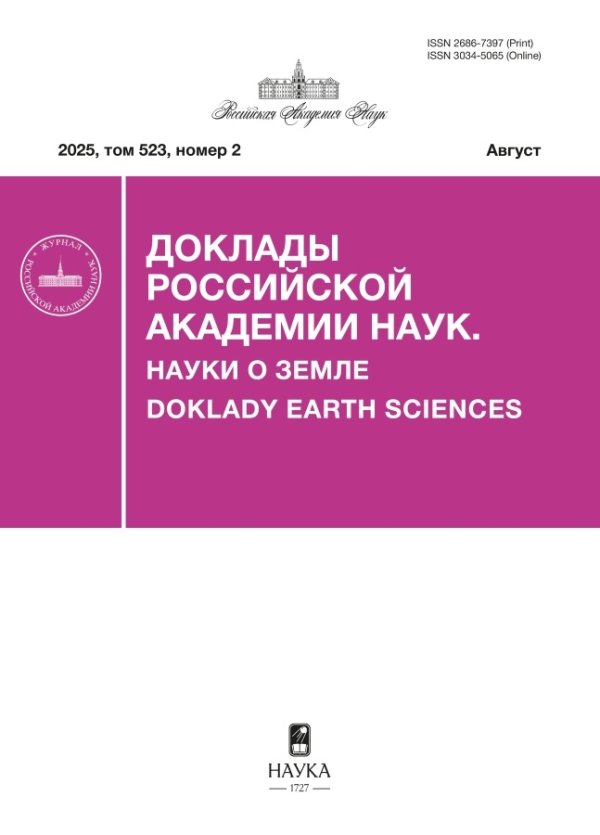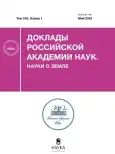Древнейшие островодужные гранитоиды Чингиз-Тарбагатайского района (Восточный Казахстан): обоснование возраста и особенности состава
- Авторы: Дегтярев К.Е.1, Лучицкая М.В.1, Третьяков А.А.1, Сальникова Е.Б.2, Плоткина Ю.В.2
-
Учреждения:
- Геологический институт Российской Академии наук
- Институт геологии и геохронологии докембрия Российской Академии наук
- Выпуск: Том 516, № 1 (2024)
- Страницы: 319-322
- Раздел: ГЕОЛОГИЯ
- Статья получена: 31.01.2025
- Статья опубликована: 18.12.2024
- URL: https://vestnik.nvsu.ru/2686-7397/article/view/650057
- DOI: https://doi.org/10.31857/S2686739724050018
- ID: 650057
Цитировать
Полный текст
Аннотация
В Чингиз-Тарбагатайском районе Восточного Казахстана впервые датированы древнейшие гранитоиды кан-чингизского комплекса, в строении которого участвуют кварцевые диориты, гранодиориты, плагиограниты и граниты. Проведено U–Pb (ID-TIMS и SIMS)-геохронологическое изучение гранитов и плагиогранитов, для которых получены оценки возраста 509±2 и 512±3 млн лет, примерно соответствующие границе раннего и среднего кембрия. Полученные данные позволяют считать возраст вулканогенно-осадочных толщ, вмещающих гранитоиды, раннекембрийским. Особенности состава гранитоидов кан-чингизского комплекса свидетельствуют об их формировании в пределах энсиматической островной дуги.
Ключевые слова
Полный текст
Об авторах
К. Е. Дегтярев
Геологический институт Российской Академии наук
Автор, ответственный за переписку.
Email: degtkir@mail.ru
академик РАН
Россия, МоскваМ. В. Лучицкая
Геологический институт Российской Академии наук
Email: degtkir@mail.ru
Россия, Москва
А. А. Третьяков
Геологический институт Российской Академии наук
Email: degtkir@mail.ru
Россия, Москва
Е. Б. Сальникова
Институт геологии и геохронологии докембрия РоссийскойАкадемии наук
Email: degtkir@mail.ru
Россия, Санкт-Петербург
Ю. В. Плоткина
Институт геологии и геохронологии докембрия РоссийскойАкадемии наук
Email: degtkir@mail.ru
Россия, Санкт-Петербург
Список литературы
- Моссаковский А. А., Руженцев С. В., Самыгин С. Г., Хераскова Т. Н. Центрально-Азиатский складчатый пояс: геодинамическая эволюция и история формирования // Геотектоника. 1993. № 6. С. 3‒32.
- Xiao W. J., Huang B. C., Han C. M., Sun S., Li J. L. A review of the western part of the Altaids: a key to understanding the architecture of accretionary orogens // Gondwana Res. 2010. V. 18. P. 253–273.
- Дегтярев К. Е. Тектоническая эволюция раннепалеозойских островодужных систем и формирование континентальной коры каледонид Казахстана. М.: ГЕОС, 2012. 289 с.
- Рязанцев А. В. Структурная зональность нижнепалеозойских комплексов в Бощекульской островодужной системе на северо-востоке Центрального Казахстана // Очерки по региональной тектонике. Т. 2: Казахстан, Тянь-Шань, Полярный Урал. М.: Наука, 2005. С. 5–39.
- Shen P., Pan H., Seitmuratova E., Yuan F., Jakupova S. A Cambrian intra-oceanic subduction system in the Bozshakol area, Kazakhstan // Litos. 2015. V. 224–226. P. 61–77.
- Геология Чингизской геоантиклинорной зоны (Центральный Казахстан). Алма-Ата: Наука, 1962. 168 с.
- Дегтярев К. Е., Шатагин К. Н., Ковач В. П., Третьяков А. А. Процессы формирования континентальной коры каледонид хребта Чингиз (Восточный Казахстан) // Геотектоника. 2015. № 6. С. 20–51.
- Ергалиев Г. Х., Пирогова Т. Е., Жемчужников В. Г., Никитина О. И., Иванова Н. И. и др. Атлас опорных геологических разрезов стратотипов фанерозоя Казахстана. Алматы: ТОО «378», 2020. 612 с.
- Геологическая карта Казахской ССР. Масштаб 1:500000. Восточно-Казахстанская серия. Объяснительная записка. Алма-Ата: Мингео СССР, 1979. 184 с.
- Tolmacheva T. J., Degtyarev K. E., Samuelson J., Holmer L. E. Middle Cambrian to Lower Ordovician from the Chingiz Mountain Range, central Kazakhstan // Alcheringa: An Ausralasian Journal of Palaeontology. 2008. V. 32. № 4. P. 443‒463.
- Звонцов В. С., Фрид Н. М. Ранний палеозой Северо-восточного Предчингизья и Западного Тарбагатая // Изв. АН КазССР. Сер. геол. 1991. № 4. С. 23–42.
- Сальникова Е. Б., Яковлева С. З., Котов А. Б., Толмачева Е. В., Плоткина Ю. В., Козловский А. М., Ярмолюк В. В., Федосеенко А. М. Кристаллогенезис циркона щелочных гранитов и особенности его U-Pb датирования (на примере Хангайского магматического ареала) // Петрология. 2014. Т. 22. № 5. С. 482–495.
- Носова А. А., Возняк А. А., Богданова С. В., Савко К. А., Лебедева Н. М., Травин А. В., Юдин Д. С., Пейдж Л., Ларионов А. Н., Постников А. В. Раннекембрийский сиенитовый и монцонитовый магматизм на юго-востоке Восточно-Европейской платформы: петрогенезис и тектоническая обстановка формирования // Петрология. 2019. Т. 27. № 4. С. 357–400.
- Larionov A. N., Andreichev V. A., Gee D. G. The Vendian alkaline igneous suite of northern Timan: ion microprobe U-Pb zircon ages of gabbros and syenite the Vendian alkaline igneous suite of northern Timan: ion microprobe U-Pb zircon ages of gabbros and syenite // Geol. Soc. 2004. V. 30. P. 69–74.
- Стратиграфический кодекс России. Издание третье, исправленное и дополненное. СПб.: Издательство ВСЕГЕИ, 2019. 96 с.
- Cohen K. M., Finney S. C., Gibbard P. L., Fan J. X. The ICS International Chronostratigraphic Chart // Episodes. 2013 (updated 02. 2022). V. 36. № 3. P. 199–204.
- Koepke J., Berndt J., Feig S. T., Holtz F. The formation of SiO2-rich melts within the deep oceanic crust by hydrous partial melting of gabbros // Contrib. Mineral. Petrol. 2007. V. 153. P. 67–84.
- Pearce J. A., Harris N. B. W., Tindle A. G. Trace element discrimination diagrams for the tectonic interpretation of granitic rocks // J. Petrol. 1984. V. 25. No. 4. P. 956–983.
- Forster H.-J., Tischendorf G., Trumbull R. B. An evaluation of the Rb vs (Y+Nb) discrimination diagram to infer tectonic setting of silicic igneous rocks // Lithos. 1997. V. 40. P. 261–293.
- Whalen J. B., Hildebrand R. S. Trace element discrimination of arc, slab failure, and A-type granitic rocks // Lithos. 2019. V. 348–349. Art. ID 105179.
Дополнительные файлы
















